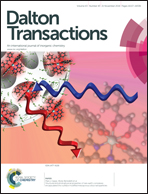Organo-functionalized metal–oxide clusters: synthesis and characterization of the reduced cationic species [NaVIV6O6{(OCH2CH2)2NH}6]+†
Abstract
A new heteropolyoxovanadium compound, [NaV6O6{(OCH2CH2)2NH}6]·(OH)0.5Cl0.5·3(H2O), was synthesized and characterized by single-crystal X-ray diffraction analysis, cyclic voltammetry, FTIR and UV-vis spectroscopy, and TGA. [NaV6O6{(OCH2CH2)2NH}6]·(OH)0.5Cl0.5·3(H2O) contains the diethanolamine functionalized oxovanadium cationic cluster, [NaVIV6O6{(OCH2CH2)2NH}6]+. The cluster cation is composed of a fully reduced cyclic {NaV6N6O18} framework which adopts an Anderson-like structure and is comprised of a ring of six edge-sharing {VO5N} octahedra linked to a central {NaO6} unit. Two (OCH2CH2–) arms of each of the six diethanolamine ligands are incorporated into the oxometalate core. FTIR spectra are consistent with the presence of expected V![[double bond, length as m-dash]](https://www.rsc.org/images/entities/char_e001.gif) Ot stretching modes and functionalization with diethanolamine. Electrochemical and UV-vis absorption properties are consistent with two distinct MLCT processes: the characteristic V
Ot stretching modes and functionalization with diethanolamine. Electrochemical and UV-vis absorption properties are consistent with two distinct MLCT processes: the characteristic V![[double bond, length as m-dash]](https://www.rsc.org/images/entities/char_e001.gif) Ot dπ–pπ interaction, and a second process occurring through the hydrogen-terminated nitrogen atoms (V–N–H) of the octahedra forming the cyclic {NaV6N6O18} core.
Ot dπ–pπ interaction, and a second process occurring through the hydrogen-terminated nitrogen atoms (V–N–H) of the octahedra forming the cyclic {NaV6N6O18} core.
![Graphical abstract: Organo-functionalized metal–oxide clusters: synthesis and characterization of the reduced cationic species [NaVIV6O6{(OCH2CH2)2NH}6]+](/en/Image/Get?imageInfo.ImageType=GA&imageInfo.ImageIdentifier.ManuscriptID=C4DT02174F&imageInfo.ImageIdentifier.Year=2014)

 Please wait while we load your content...
Please wait while we load your content...